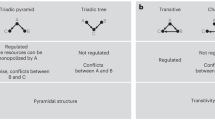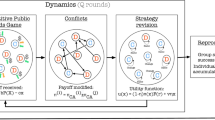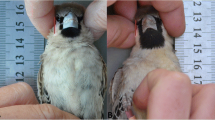Abstract
In previous papers (Theraulaz et al., 1995; Bonabeau et al., 1996) we suggested, following Hogeweg and Hesper (1983, 1985), that the formation of dominance orders in animal societies could result from a self-organizing process involving a double reinforcement mechanism: winners reinforce their probability of winning and losers reinforce their probability of losing. This assumption, and subsequent models relying on it, were based on empirical data on primitively eusocial wasps (Polistes dominulus). By reanalysing some of the experimental data that was previously thought to be irrelevant, we show that it is impossible to distinguish this assumption from a competing assumption based on preexisting differences among individuals. We propose experiments to help discriminate between the two assumptions and their corresponding models—the self-organization model and the correlational model. We urge other researchers to be cautious when interpreting their dominance data with the ’self-organization mindset’; in particular, ‘winner and loser effects’, which are often considered to give support to the self-organization assumption, are equally consistent with the correlational assumption.
Similar content being viewed by others
References
Alexander, R. D. (1961). Aggressiveness, territoriality, and sexual behaviour in field crickets (Orthoptera: Gryllidae). Behaviour 17, 130–223.
Allee, W. C. (1942). Social dominance and subordination among vertebrates. Levels of integration in biological and social systems. Biol. Symp. 8, 139–162.
Allee, W. C. (1951). Cooperation Among Animals, New York: Henry Schulman.
Allee, W. C. (1952). Dominance and hierarchy in societies of vertebrates. Colloq. Int. CNRS 34, 157–181.
Baldwin, J. D. (1971). The social organization of a semifree-ranging troop of squirrel monkeys (Saimiri sciureus). Folia Primatol. 14, 23–50.
Barchas, P. R. and S. D. Mendoza (1984). Emergent hierarchical relationships in rhesus macaques:an application of Chase’s model, in Social Hierarchies: Essays Toward a Sociophysiological Perspective, P. R. Barchas (Ed.), Wesport, CT: Greenwood Press, pp. 81–95.
Barton, E. P., S. L. Donaldson, M. A. Ross and J. L. Albright (1974). Social rank and social index as related to age, body weight and milk production in dairy cows. Proc. Ind. Acad. Sci. 83, 473–477.
Beaugrand, J. P. and R. C. Zayan (1984). An experimental model of aggressive dominance in Xiphophorus helleri (Pisces: Poeciliidae). Behav. Process. 10, 1–53.
Boice, R. and D. W. Witter (1969). Hierarchical feeding behaviour in the leopard frog (Rana pipiens). Anim. Behav. 17, 474–479.
Bonabeau, E., G. Theraulaz and J. L. Deneubourg (1996). Mathematical models of selforganizing hierarchies in animal societies. Bull. Math. Biol. 58, 661–719.
Bourke, A. F. G. (1988). Dominance orders, worker reproduction, and queen-worker conflict in the slave-making ant Harpagoxenus sublaevis. Behav. Ecol. Sociobiol. 23, 323–333.
Bovbjerg, R. V. (1956). Some factors affecting aggressive behaviour in crayfish. Physiol. Zool. 29, 127–136.
Bovbjerg, R. V. and S. L. Stephen (1971). Behavioural changes in crayfish with increased population density. Bull. Ecol. Soc. Am. 52, 37–38.
Burk, T. E. (1979). An analysis of social behaviour in crickets, D. Phil. thesis, University of Oxford, Oxford, U.K.
Candland, D. K. and A. I. Leshner (1971). Formation of squirrel monkey dominance order is correlated with endocrine output. Bull. Ecol. Soc. Am. 52, 54.
Chase, I. D. (1974). Models of hierarchy formation in animal societies. Behav. Sci. 19, 374–382.
Chase, I. D. (1980). Social process and hierarchy formation in small groups: a comparative perspective. Am. Sociol. Rev. 45, 905–924.
Chase, I. D. (1982a). Dynamics of hierarchy formation: the sequential development of dominance relationships. Behaviour 80, 218–240.
Chase, I. D. (1982b). Behavioral sequences during dominance hierarchy formation in chickens. Science 216, 439–440.
Chase, I. D. (1985). The sequential analysis of aggressive acts during hierarchy formation: an application of the ‘jigsaw’ puzzle approach. Anim. Behav. 33, 86–100.
Chase, I. D. (1986). Explanations of hierarchy structure. Anim. Behav. 34, 1265–1267.
Chase, I. D. and S. Rohwer (1987). Two methods for quantifying the development of dominance hierarchies in large groups with applications to Harris’ sparrows. Anim. Behav. 35, 1113–1128.
Cole, B. J. (1981). Dominance hierarchies in Leptothorax ants. Science 212, 83–84.
Deleurance, E. P. (1946). Une régulation sociale à base sensorielle périphérique: l’inhibition de la ponte des ouvrirès par la présence de la fondatrice chez les Polistes (Hyménoptères Vespidae). Compt. Rend. Acad. Sci. Paris 223, 871–872.
Dropkin, J. A. and G. J. Gamboa (1981). Physical comparisons of foundresses of the paper wasp Polistes metricus (Hymenoptera: Vespidae). Can. Entomol. 113, 457–461.
Evans, H. E. and M. J. West Eberhard (1970). The Wasps, Chicago, IL: University of Michigan Press.
Evans, L. T. (1951). Field study of the social behaviour of the black lizard, Ctenosaura pectinata. Am Museum Novitates 1943.
Evans, L. T. (1953). Tail display in an iguanid lizard, Liocephalus carinatus coryi. Copeia 1, 50–54.
Francis, R. C. (1983). Experimental effects on agonistic behaviour in the paradise fish, Macropodus opercularis. Behaviour 85, 292–313.
Franks, N. R. and E. Scovell (1983). Dominance and reproductive success among slave-making worker ants. Nature 304, 724–725.
Gervet, J. (1962). Etudes de l’effet de groupe sur la ponte dans la société polygyne de Polistes gallicus L. (hymen. vesp). Insectes Soc. 9, 231–263.
Gervet, J. (1964). La ponte et sa régulation dans la sociét’e polygyne de Polistes gallicus L. Ann. Sci. Nat. Zool. 6, 601–778.
Ginsburg, B. and W. C. Allee (1975). Some effects of conditioning on social dominance and subordination in inbred strains of mice, in Social Hierarchy and Dominance, M. W. Schein (Ed.), Dowden: Hutchinson and Ross.
Glass, C. W. and F. A. Huntingford (1988). Initiation and resolution of fights between swimming crabs (Liocarcinus depurator). Ethology 77, 237–249.
Gössmann, C. and R. Huber (1999). Behavioral mechanisms in the formation and maintenance of hierarchy in crayfish (Astacus astacus). Unpublished.
Guhl, A. M. (1968). Social stability and social inertia in chickens. Anim. Behav. 16, 219–232.
Haubrich, R. (1961). Hierarchical behaviour in the South African clawed frog, Xenopus laevis Daudin. Anim. Behav. 9, 71–76.
Heinze, J. (1990). Dominance behaviour among ant females. Naturwissenchaften 77, 41–43.
Heinze, J., B. Hölldobler and C. Peeters (1994). Conflict and cooperation in ants societies. Naturwissenchaften 81, 489–497.
Heldmann, G. (1936). Über das leben auf waben mit mehreren überwinterten weibchen von Polistes gallica L. Biol. Zentral. 56, 389–400.
Hemelrijk, C. K. (1996). Dominance interactions, spatial dynamics and emergent reciprocity in a virtual world, in From Animals to Animats 4. Proceedings of the Fourth International Conference on Simulation of Adaptive Behavior, P. Maes, M. J. Mataric, J.-A. Meyer, J. Pollack and S. W. Wilson (Eds), Cambridge, MA: MIT Press, pp. 545–552.
Hogeweg, P. and B. Hesper (1983). The ontogeny of the interaction structure in bumblebee colonies: a mirror model. Behav. Ecol. Sociobiol. 12, 271–283.
Hogeweg, P. and B. Hesper (1985). Socioinformatic processes: MIRROR modelling methodology. J. Theor. Biol. 113, 311–330.
Huber, R. and E. A. Kravitz (1995). A quantitative analysis of agonistic behavior in juvenile American lobsters (Homarus americanus L) brain. Behav. Evol. 46, 72–83.
Huber, R., K. Smith, A. Delago, K. Isaksson and E. A. Kravitz (1997). Serotonin and aggressive motivation in crustaceans: altering the decision to retreat. Proc. Natl. Acad. Sci. USA 94, 5939–5942.
Huber, R. and A. Delago (1999). Serotonin alters decisions to withdraw in fighting crayfish, Astacus astacus: the motivational concept revisited. J. Comparative Physiol. A, (in press).
Jachowsky, R. L. (1974). Agonistic behaviour of the blue crab, Callinectes sapidus Rathbun. Behaviour 50, 232–253.
Jäger, E. and L. A. Segel (1992). On the distribution of dominance in populations of social organisms. SIAM J. Appl. Math. 52, 1442–1468.
Jeanne, R. L. (1991). The Social Biology of Wasps, K. G. Ross and R. G. Matthews (Eds), Ithaca, NY: Cornell University Press, pp. 389–425.
Kummer, H. (1968). Social Organization of Hamadrayas Baboons, Chicago: University of Chicago Press.
Lowe, M. E. (1956). Dominance-subordinance relationships in the crayfish Cambarellus shufeldti. Tulane Stud. Zool., New Orleans 4, 139–170.
McBride, G. (1958). The measurement of aggressiveness in the domestic hen. Anim. Behav. 6, 87–91.
Medeiros, F. N. S., L. E. Lopes, P. R. S. Moutinho, P. S. Oliveira and B. Hölldobler (1992). Functional polygyny, agonistic interactions and reproductive dominance in the neotropical ant Odontomachus chelifer (Hymenoptera, Formicidae, Ponerinae). Ethology 91, 134–146.
Mendoza, S. D. and P. R. Barchas (1983). Behavioral processes leading to linear status hierarchies following group formation in rhesus macaques. J. Human Evol. 12, 185–192.
Nijhout, H. F. (1994). Insect Hormones, Princeton, NJ: Princeton University Press.
Noonan, K. M. (1981). Individual strategies of inclusive-fitness-maximizing in Polistes fuscatus foundresses, in Natural Selection and Social Behavior, R. D. Alexander and W. D. Tinkle (Eds), New York: Chiron Press, pp. 18–44.
Oliveira, P. S. and B. Hölldobler (1990). Dominance orders in the ponerine ant Pachycondyla apicalis (Hymenoptera, Formicidae). Behav. Ecol. Sociobiol. 27, 385–393.
Page, R. E. (1997). The evolution of insect societies. Endeavour 21, 114–120.
Pardi, L. (1942). Ricerche sui Polistini. V. La poliginia initiale di Polistes gallicus (L.). Boll. Ist. Entom. Univ. Bologna 14, 1–106.
Pardi, L. (1946). Richerche sui Polistini. VII. La ‘dominazione’ e il ciclo ovario annuale in Polistes gallicus (L.). Boll. Ist. Entom. Univ. Bologna 15, 25–84.
Pardi, L. (1948). Dominance order in Polistes wasps. Physiol. Zool. 21, 1–13.
Reeve, H. K. (1991). Polistes, in The Social Biology of Wasps, K. G. Ross and R. G. Matthews (Eds), Ithaca, NY: Cornell University Press, pp. 99–148.
Röseler, P.-F., I. Röseler and A. Strambi (1980). The activity of corpora allata in dominant and subordinated females of the wasp Polistes gallicus. Insectes Soc. 27, 97–107.
Röseler, P.-F., I. Röseler, A. Strambi and R. Augier (1984). Influence of insect hormones on the establishment of dominance hierarchies among foundresses of the paper wasp Polistes gallicus. Behav. Ecol. Sociobiol. 15, 133–142.
Röseler, P.-F. (1985). Endocrine basis of dominance and reproduction in polistine paper wasps. Fortschr. Zool. 31, 259–272.
Röseler, P.-F., I. Röseler and A. Strambi (1985). Role of ovaries and ecdysteroids in dominance hierarchy establishment among foundresses of the primitively social wasp, Polistes gallicus. Behav. Ecol. Sociobiol. 18, 9–13.
Röseler, P.-F., I. Röseler and A. Strambi (1986). Studies of the dominance hierarchy in the paper wasp, Polistes gallicus (L.) (Hymenoptera, Vespidae). Mon. Zool. Ital. 20, 283–290.
Röseler, P.-F. and I. Röseler (1989). Dominance of ovariectomized foundresses of the paper wasp Polistes gallicus. Insectes Soc. 36, 219–234.
Röseler, P.-F. (1991). Reproductive competition during colony establishment, in The Social Biology of Wasps, K. G. Ross and R. G. Matthews (Eds), Ithaca, NY: Cornell University Press, pp. 309–335.
Savoyard, L. et al. (1999). The communicative meaning of body oscillations in the social wasp Polistes fuscatus (Hymenoptera: Vespidae). Insectes Soc. 45, 215–230.
Schein, M. W. and M. H. Fohrman (1955). Social dominance relationships in a herd of daily cattle. Br. J. Anim. Behav. 3, 45–55.
Schjelderup-Ebbe, T. (1913). Hönsenes stemme. Bidrag til hönsenes psykologi. Naturen 37, 262–276.
Schjelderup-Ebbe, T. (1922). Beiträge zur sozialpsychologie des haushuhns. Z. Psychol. 88, 225–252.
Slater, P. J. B. (1986). Individual differences and dominance hierarchies. Anim. Behav. 34, 1264–1265.
Theraulaz, G. (1991). Morphogenèse et auto-organisation des comportements dans les colonies de guêpes Polistes dominulus (Christ), PhD dissertation, Université de Provence, Aix-Marseille I.
Theraulaz, G., M. Pratte and J. Gervet (1989). Effects of removal of α-individuals from a Polistes dominulus Christ wasp society: changes in behavioural patterns resulting from hierarchical changes. Actes Coll. Insectes Soc. 5, 169–179.
Theraulaz, G., M. Pratte and J. Gervet (1990). Behavioural profiles in Polistes dominulus (Christ) wasp societies: a quantitative study. Behaviour 113, 223–250.
Theraulaz, G., J. Gervet and S. Semenoff-Tian-Chansky (1991). Social regulation of foraging activities in Polistes dominulus Christ: a systemic approach to behavioural organization. Behaviour 116, 292–320.
Theraulaz, G., J. Gervet, B. Thon, M. Pratte and S. Semenoff-Tian-Chansky (1992). The dynamics of colony organization in the primitively eusocial wasp Polistes dominulus (Christ). Ethology 91, 177–202.
Theraulaz, G., E. Bonabeau and J.-L. Deneubourg (1995). Self-organization of hierarchies in animal societies: the case of the primitively eusocial wasp Polistes dominulus Christ. J. Theor. Biol. 174, 313–323.
Thierry, B. (1985). Patterns of agonistic interactions in three species of macaques (Macaca mulatta, M. fascicularis, M. tonkeana). Aggress. Behav. 11, 223–233.
Tyler, S. J. (1972). The behaviour and social organisation of the new forest ponies. Anim. Behav. Monogr. 48, 223–233.
Turillazzi, S. and L. Pardi (1977). Body size and hierarchy in polygynic nests of Polistes gallicus (L) (Hymenoptera Vespidae). Mon. Zool. Ital. 16, 75–88.
Turillazzi, S., M. T. Marino-Piccioli, L. Hervatin and L. Pardi (1982). Reproductive capacity of single foundress and associated foundress females of Polistes gallicus (L) (Hymenoptera Vespidae). Mon. Zool. Ital. 16, 75–88.
Van de Poll, N. E., F. De Jonge, H. G. Van Oyen and J. Van Pett (1982). Aggressive behaviour in rats: effects of winning and losing on subsequent aggressive interactions. Behav. Process. 7, 143–155.
Van Honk, C. and P. Hogeweg (1981). The ontogeny of the social structure in a captive Bombus terrestris colony. Behav. Ecol. Sociobiol. 9, 111–119.
Velthuis, H. H. W. (1976). Egg laying, aggression and dominance in bees, in Proceedings of the XVth International Congress of Entomology, Washington, DC: National Bureau of Standards, pp. 436–449.
West Eberhard, M. J. (1969). The Social Biology of Polistine Wasps, Miscellaneous publications, Museum of Zoology, University of Michigan, Ann. Arbor. 140, 1–101
Wilson, E. O. (1971). The Insect Societies, Cambridge, MA: Belknap Press.
Wilson, E. O. (1975). Sociobiology: The New Synthesis, Cambridge, MA: Harvard University Press.
Author information
Authors and Affiliations
Rights and permissions
About this article
Cite this article
Bonabeau, E., Theraulaz, G. & Deneubourg, JL. Dominance orders in animal societies: The self-organization hypothesis revisited. Bull. Math. Biol. 61, 727–757 (1999). https://doi.org/10.1006/bulm.1999.0108
Received:
Accepted:
Issue Date:
DOI: https://doi.org/10.1006/bulm.1999.0108




